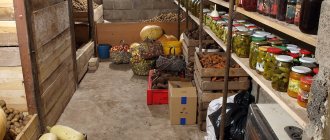It is simply impossible not to love dahlias. Everyone who has their own plot of land always tries to make room for at least a couple of bushes of these amazing flowers. Today there are a lot of varieties and varieties, so everyone can find a plant variety for themselves.
Only when the flowering time ends and the first frosts strike does the question of how to store dahlias in winter at home become acute, so as to enjoy their lush flowering next year. In this article, experts from the Agronom.guru portal will talk about how to properly store planting material, what conditions are necessary for this, and what to do if the tubers did not survive the winter well.
Dahlias amaze with their beauty and grace. They delight the eye with a riot of colors from the beginning of summer until the frosts
Preparing for winter - what needs to be done with them before storage
After the first frost hits, they begin preparing the dahlias for wintering. First of all, they carefully inspect the bushes and discard plants with obvious signs of disease. You should not feel sorry for them and try to give them a chance, because during storage healthy tubers may become infected and all the flowers will die. After culling, they begin to clean the soil around the bushes.
Plants that show obvious signs of any disease are immediately burned to prevent the outbreak from spreading. Weak dahlias are removed and sent to rot in a compost pit. It is noteworthy that the tubers accumulate a certain supply of moisture so that they can withstand drought. During storage, excess moisture can provoke rotting processes, so you should stop watering the flowers a week before the intended harvest.
Frozen dahlia tops should be trimmed
If frosts came unexpectedly and the dahlias did not have time to prepare for the winter period, then there is no need to rush to remove them. The tubers are left in the ground for as long as time allows. Frozen tops are cut off, leaving 15 cm above the soil surface. In this state, you can keep the bushes on the site for up to 20 days, which will give them the opportunity to ripen.
Dahlias cannot overwinter in open ground; in the fall they must be dug up and stored indoors. To do this, carefully dig up the soil around the bush with a shovel, remove the tubers and shake them off any remaining soil. You must work extremely carefully, trying not to injure the fragile roots. Finally, they are laid out in the open air and allowed to dry thoroughly.
After digging, the tubers must be thoroughly dried.
After the excavated material has dried, it is inspected to identify damage or the presence of diseases. They also get rid of old tubers that will no longer be able to produce buds next season. In addition, old rhizomes are very poorly preserved until spring, so it is not advisable to send them for the winter. They are easy to distinguish by their dark color, pronounced tuberosity and very large size compared to young ones.
There are two conflicting opinions about whether it is worth washing tubers before sending them for the winter. Some gardeners are supporters of the theory that washing significantly reduces shelf life and destroys the cambium. Others tend to believe that clean roots show damage and disease better.
Digging and preparing dahlias
In order for the flowers to survive the winter well and take root in the open ground without problems in the spring, they must be properly dug up and prepared. You should dig up only those flowers that have already bloomed; it is in such dahlias that the tubers are strong and ripe.
Some gardeners prefer to store the roots in open ground for as long as possible (until the first severe frost). And to keep the heat in the ground, you just need to hill up the soil.
After a cold snap, the time required to dig up dahlias is short, as the flower may freeze and begin to rot. And if warming comes after frost, new young shoots will appear and the next growing season will begin. Considering that winter is approaching, the flower has every chance of dying. Dahlias must be dug up very carefully, and they should not be rocked or pulled out, as there is a risk of damaging the root system of the flower.
The excavation process occurs as follows:
- First, the bush is pruned with well-sharpened pruners. Pruning is carried out 20 centimeters above the root collar.
- After this, the plant is dug in a circle.
- Using a fork, you need to pry up the earthen lump and pull out the dahlia roots.
Dug up dahlias should be processed. But first you need to shake the roots off the ground, and then put them in a bucket of water or rinse them under warm running water. Now that the tubers have been cleared of soil, they must be placed in a weak solution of manganese for half an hour.
Next, dry the dahlias. To do this, place the roots in a cool room, such as a basement or cellar. The tubers lie there for five to six days. After drying, the roots can be divided so as not to have to do this in the spring, but they can also be stored as a whole. But we must take into account that if the dahlias only grew for the first year, then there is no need to divide them; it is better to store them whole, since the young tubers are not strong enough.
We recommend watching the video at the end of the article, which shows how to properly dig up and prepare dahlias for storage.
How to store after digging - nuances of the storage mode
It is very difficult to create ideal conditions for storing dahlias, but it is possible to get closer to them. It is especially useful for beginning gardeners to become familiar with the preferences of capricious beauties. Otherwise, there is a risk of destroying the tubers due to improper storage. So, you dug up the dahlias. Storing tubers in winter is best done under the following conditions:
- air temperature – at +5°С;
- optimal humidity - 60−75%;
- good ventilation of the room;
- air must circulate.
Proper storage is the key to success in the next season.
If you ensure the last two points listed, then the risk of fungal infections is minimized. It wouldn’t hurt to pre-disinfect the room or fumigate it with sulfur. The roots are laid in no more than 2 rows. The surface must be dry. The following are used as a substrate:
- dry sand (in rare cases - earth);
- sawdust or large wood shavings;
- any wooden surface.
New technique: wrapping tubers in cling film
Recently, it has been practiced to wrap tubers in cling film before sending them to storage, but this technique has a sufficient number of opponents who are inclined to argue that in such conditions fungal diseases multiply, plants breathe poorly, and the chances of surviving until They don't have much spring.
Personally, I had a positive experience of storing dahlias in cling film (there was no other option), however, I will not say that this is one hundred percent effective.
What to store in
- There are special storage barrels made from a metal or plastic base. In such a container it is convenient to store dahlias right on the site. It is buried in a dug hole and covered with a lid.
- You can also store tubers in bags of 2 to 5 divisions. In this case, they must be placed in a vertical direction.
- You can use a basket for storage in the basement. It is necessary to place the tubers in it so that the neck is at the top. It is required that they fit tightly to each other.
Thus, it is worth storing dahlias during the winter. To ripen, it is recommended to move them to a warmer place where the air temperature is about 14 degrees.
How to store tubers at home - why and how to label the roots
If there are at least several varieties of dahlias in the flower industry, then you will need to resort to labeling. This procedure is done to avoid re-sorting. In addition, the strongest tubers are marked with special signs, for example, asterisks. With the beginning of the new season, they can be used to obtain cuttings. Self-made tags are used for labeling. A piece of paper or a piece of plastic with the appropriate inscription is attached to the rope.
Labeling tubers will help avoid unwanted misgrading
You can also use the digital method for marking - apply it to the tubers or attach numbers in a certain order. In this case, you will also need an additional notebook for notes, where you will keep notes about which variety is indicated by which number. This procedure helps not to confuse the varieties of flowers and plant them in the garden bed in the required sequence.
Subsequent actions until storage
Those gardeners who grow many different varieties of dahlias can easily get confused, since the tubers of all colors are like twin brothers, very similar to each other. In order to know where which variety will be stored, the tubers are usually labeled. This can be done in various ways:
- The first way is to number each tuber, and then add the number and name of the variety to the list.
- The second option is this: having picked a flower during flowering and dried it, flower growers tie it to a tuber and already know exactly what color, variety and variety it is.
- The third method is the most convenient - write the name of the variety directly on the tuber, then you certainly won’t get confused.
All these measures are needed by those who are fond of dahlias and have several dozen varieties and types of plants. Marking allows you to control the storage and planting of flowers in the spring with an understanding of how tall, voluminous and spreading they are.
Storage Methods
It may seem strange to beginners, but there are several effective methods for preserving dahlia tubers in winter. You should choose the one that suits you best, taking into account the conditions, the availability of space and the ability to control the condition of the roots.
In sandboxes
One of the most common, affordable and reliable ways to preserve tubers. You will need to prepare a container with a volume of at least 20 liters in advance (the volume depends on the number and size of the roots). Dry sand is poured into it, and then dahlias are laid in 1 or 2 layers. A layer of burlap is placed on top. As evidenced by reviews from experienced flower growers, the roots are simply perfectly preserved in this way. In addition, if necessary, it is possible to control the condition of the tubers.
Storing tubers in boxes with sand is an old and proven method
The disadvantage of the method of preserving planting material in sand is that a lot of sand is needed. In the spring, the flowers may begin to germinate ahead of schedule, which will cause some inconvenience. The main threat to plants when stored in sand is excess moisture. Under no circumstances should the sand be moistened, even if it seems that it is very dry. Moisture in this case will promote rotting. Dry dahlias can still be revived, but rotten ones are no longer possible.
In boxes with sawdust
This technique is also worthy and effective for preserving tubers. However, for this you must choose large sawdust. It's even better to use shavings. Fine sawdust can draw out and absorb all available moisture. Often, both experienced and novice gardeners make a grave mistake when trying to preserve dahlias in sawdust - they place them in plastic bags. As a result, condensation accumulates, and the roots simply rot from excess moisture.
Storing dahlias in boxes with sawdust is a very effective method.
It is not recommended to store dahlia tubers near any vegetables or potatoes. The fact is that an unwanted excess of moisture appears there, leading to the emergence and spread of fungal diseases.
Use of vermiculite
A material such as vermiculite is able to perfectly retain the required amount of moisture. In such conditions there is no need to worry about the roots drying out. However, with the slightest increase in temperature, flowers may sprout prematurely and form suction roots, which is extremely undesirable. To avoid such troubles, it is better to purchase not garden vermiculite, but a special one - coarse-grained.
Storing tubers in vermiculite helps prevent them from drying out.
To implement this method, prepare a container of the required volume and pour a layer of vermiculite on its bottom. After this, a layer of tubers is laid. In this sequence, the entire volume is filled. Finally, a layer of cellophane or polyethylene is laid on top, and the container is sent to a cool place where it will be stored.
Waxing
This method is used only by the most skilled gardeners, since it requires a lot of labor and time. The efficiency of waxing dahlia tubers is very high. Moisture cannot evaporate through paraffin, thereby avoiding drying out. And the high temperatures that operate during the processing process help kill all existing pathogens.
Waxing tubers takes a lot of effort and time, but is very effective.
As soon as the paraffin hardens, the roots receive reliable protection from the effects of harmful environmental factors. However, this technique should only be used for early plant varieties, since it promotes later awakening of the buds and the formation of suction roots. The method is also relevant for those who are thinking about the question of how to preserve dahlias purchased in February. After all, at this time, as a rule, it is not possible to get dry sand or sawdust. Let's take a closer look at waxing technology.
The finished paraffin or candles should be finely chopped and placed in a metal pan, adding water. All this is placed on top of another container of water, thus creating a water bath. The paraffin is melted over very low heat until the thickness of the molten layer reaches a couple of centimeters. If the roots will not fit in the pan, they will need to be separated. Prepared and dried tubers are tied with thread and quickly dipped in paraffin, after which they are taken out and wait for the substance to harden. In the open air this happens very quickly.
Gladioli: harvesting and storing bulbs, practical tips for growing and storing. In a special publication on our portal, we will talk in detail about how to remove and store gladioli bulbs.
You will learn the necessary parameters for storing gladioli in winter at home and the rules for planting and caring for gladioli in open ground.
Methods for laying tubers for wintering
In the basement with optimal temperature and humidity, dahlias are stored well on wooden shelves in bags, boxes or nets
It’s just important not to place them on cement, as it draws moisture out of the plants.
Before storing dahlia tubers in a cellar or living room, you need to make sure that suitable conditions exist. It would be wiser to leave a protective shell to protect the tubers from drying out. You can do this in two ways:
- For undivided roots, it is worth preparing a mash. The clay is diluted to the state of liquid sour cream, the rhizome is dipped into it and left in the room to dry for 2-3 days. In such a shell, dahlias can be stored even on the floor of the cellar.
- Individual tubers of early varieties are treated with paraffin. Place several chopped paraffin candles into a container and pour water. The pan is kept in a water bath until the paraffin melts. After this, the fire is turned off. The tubers are tied with a thread, one by one they are lowered into the pan and immediately removed. After a few hours, the plants are placed in boxes. There is no need to clean off paraffin in the spring; it does not prevent shoots from germinating. It is enough to cover the planting material with wet peat in April and move it to a warm room. After 7-10 days, buds will appear.
It is possible to store in boxes with coarse vermiculite or expanded perlite. Dahlias are prepared in the following sequence:
- The bottom and walls of the container are lined with newspapers in 8-10 layers. This is necessary so that the tree does not take moisture from the flowers.
- A layer of protective material is poured onto the bottom of the box, then the nodules are laid so that they do not touch each other.
- Protective material is again poured over the dahlias. The operation is repeated twice. The total volume of vermiculite should be equal to the volume of roots placed in the container.
- The box is covered with film and then sealed tightly.
Sand, peat and plastic bags to preserve tubers
Dahlias will stay well in the sand until spring. The box is filled as follows:
- Pour a bucket of dry, or preferably calcined, sand onto the bottom.
- 1-2 layers of roots are laid on the sand cushion.
- Another bucket of sand is poured onto the planting material.
- The container is covered with burlap.
Many gardeners also prefer to contain planting material in peat, wood shavings or sawdust. Protective material is poured into a box and flowers are placed on it so that they do not touch each other. Layers are repeated 2-3 times. Cover the filled container with a lid. Replacing peat with moss is highly undesirable. With high humidity, this material will absorb a lot of water and the roots will rot. In dry air, on the contrary, the moss will draw water from the plants and they will dry out.
Storage methods
The option with plastic bags is optimal for an apartment without utility rooms. The processed flowers are placed in dark film bags, sprinkled with large sawdust. The filled container is tied and holes are made in it for ventilation. The bags are placed in cardboard boxes and kept in the coolest place.
If plastic bags are not available, cling film will do. The roll is unwound a little, and the tuber is wrapped in one layer. Place the next root nearby and wrap the dahlias in a common layer of film. The procedure is repeated until there are 6 flowers in the package. In this form, planting material is stored in a cellar or refrigerator.
How can flower pots and a refrigerator help preserve dahlias?
The refrigerator is ideal if you don’t have a cellar. In this case, each tuber is wrapped in parchment or canvas, then tied with twine and placed in vegetable boxes. In winter, dahlias are turned over from time to time. If the packaging becomes wet, it must be changed, otherwise the tuber will rot.
Flower pots are only suitable for varieties that form too small tubers and do not lie well. They are grown in pots dug into the ground and stored in a special way:
- After freezing, the agrofibre is removed from the flower and the stem of the plant is cut to 5 cm.
- The pot is dug out of the soil, all roots are removed from the surface of the soil.
- The pot is wrapped in newspapers 5-6 times and tied with twine.
- The packaged flower is placed in a black plastic bag and taken to the cellar.
- Before planting, the dahlia is brought into the house, unwrapped and watered until its buds awaken.
- The tubers are dug up, divided, and planted in new pots.
Knowing how to remove dahlias from the site and preserve them during the winter, you can grow these flowers as a perennial crop in both southern and cold regions.
Where to store - expert advice
It is important to choose not only the right method for storing dahlias in winter, but also to choose a good place for this. There are several options for where you can place the roots for safekeeping. Which one to give preference must be determined based on your capabilities.
The correct choice of storage location for dahlias guarantees their integrity
In the basement
If you have a basement, then it is recommended to arrange shelving there to store dahlia planting material. Subsequently, boxes or boxes can be installed on them. It is important to know what level of humidity and temperature remain in the room throughout the season. These factors significantly affect the safety of planting material.
It is convenient to store dahlias on racks in the basement
Tubers can be stored by placing them on shelves. However, if the basement is dry, then you will need to regularly humidify the air using a spray bottle, which is extremely inconvenient. Several times during the entire storage period it is necessary to sort through the root tubers and remove any that are damaged or have signs of disease. If the damage is minor, then you can cut off the sore spot, and then treat it with brilliant green, a good fungicide, or a strong solution of manganese. If the nodules begin to fade, then try to slightly increase the humidity level in the room by spraying with a spray bottle.
In the cellar
Dahlias love constant temperatures and do not tolerate freezing. If you have a cellar, then you need to know to what minimum the temperature in it can drop in the coldest months. If freezing is possible, insulation methods should be considered in advance.
A good cellar will help preserve dahlia tubers
The ideal cellar for good preservation of dahlia planting material is considered to be a cool and humid room in which the air temperature ranges from +1°C to +7°C and the humidity is maintained at 80-100%. In such conditions, the roots will not dry out or sprout prematurely. Not ideal, but an acceptable option would be a cool but dry cellar. But it’s better to avoid a warm and humid room altogether.
In the apartment
How to preserve dahlias in an apartment until spring? It is very problematic to preserve dahlias until spring. But nothing is impossible, and in the absence of other options, you can achieve the desired result. The main problem is a significant excess of the temperature in the apartment above those recommended for good preservation of root tubers. If you have a small number of roots, they can easily be placed in the plus compartment of the refrigerator. The fact that there is a lot of planting material will cause more inconvenience.
Preserving dahlias in apartment conditions is problematic, but possible
To store dahlias in an apartment, you can use well-insulated boxes that are placed on a closed balcony or loggia. In the event of a threat of a strong drop in temperature, when the thermometer drops below zero, the boxes are brought directly into the apartment and installed in the coolest place. As a rule, it is located near the balcony door. As soon as the threat of freezing has passed, the containers are returned to the balcony.
Determine the name of a garden flower from a photo. In a special publication on our portal we will talk in detail about garden flowers. You will learn about the types of garden flowers, perennials that winter in open ground and look at the photo gallery.
Useful tips
To ensure that dahlias delight their owners in the next planting period, experienced gardeners give several important tips:
- Dahlia tubers are best purchased in modern specialized stores. Such plants are less susceptible to harmful bacteria.
- Maintaining temperature conditions is the most important point in storing bulbs. If the temperature drops below zero, the tubers will simply freeze.
- After wintering, the dahlia roots need to be divided. Otherwise, they may not ascend.
- If you plan to grow a large plant, it must be additionally fed from the moment it is planted in the ground.
What to do after winter storage, how to revive them
With warmer weather approaching, novice gardeners are thinking about what to do with dahlias after winter. It’s good if you got the tubers from the basement in perfect condition. But often the opposite is true, and it will take some effort to properly awaken the flower. The main spring problem, as practice and numerous reviews show, is the drying out of the roots. How to revive dahlias after winter, and is there any hope that they will bloom wildly?
A wilted tuber can still be revived
If the tubers have not completely dried out, but only withered, then they immediately begin rehabilitation. There is no need to rush to throw away the plant - it will always be done in time. You should take a container of suitable size and fill it with nutritious soil, peat or simple sawdust. Tubers are placed horizontally in this filler, trying not to bury them. The root collar must remain open. Plantings must be generously sprayed with zircon or Epin-Extra, diluted in accordance with the requirements in the attached instructions. Place the containers on a windowsill or in a well-lit place, placing plain paper on the glass. This will ensure good dispersion of the sun's rays. This procedure should be carried out in early March, depending on weather conditions.
Tubers after resuscitation begin to sprout after 3 weeks. For 3 weeks, carefully monitor the behavior of the tubers, preventing the filler from drying out and carrying out regular moistening. Under no circumstances should you allow excess moisture, much less stagnation of water. This will lead to the onset of rotting. After a month, you will find that the growth points begin to come to life (provided that the plant has not died). It is worth taking care of good lighting, because plants can stretch a lot. Moderate watering is required, but no fertilizing is necessary.
You can revive dahlias using a transparent plastic bag.
How to revive dahlias after winter if there is no filler? The method is, of course, risky, but if there is no other choice, it’s worth a try. You need to take a transparent plastic bag that has not been used before and place the spine in it. Next, prepare a growth stimulator solution or purchase a pre-prepared one and spray the tuber with it, then lightly tie the bag (to allow air access). Place everything in a well-lit, warm place and observe. If the moisture evaporates, additional spraying is carried out. As soon as the sprouts reach a height of 5 cm, they can be planted in the garden bed or in separate containers (depending on weather conditions).
Properly reanimated dahlias delight with exuberant flowering
When planting dahlia seedlings obtained in this way in open ground, they must be hilled. If there is a threat of night spring frosts, then the plants are covered with non-woven material. Agrospan, as well as Lutrasil, are suitable for this.
In this article we tried to talk in detail about how to revive dahlias after winter. What to do - the video will provide additional useful information and help you use our advice more effectively in practice.
Can it be stored in the refrigerator?
Indoor storage of dahlias can cause drying out of the rhizomes or untimely germination of buds. But storing in the refrigerator is dangerous due to the rotting of the tubers because the microclimate remains quite humid and cold.
If there are few dahlia bulbs, then for storage in the refrigerator they are placed in a plastic bag filled with wet peat and having holes for air circulation. It is recommended to place the tubers in the compartment for vegetables and fruits - a constant temperature is maintained in this area. To be more on the safe side, the tubers can be treated with paraffin before putting them in the refrigerator.
Types of dahlias
Dahlias begin to bloom in late summer and do not fade until autumn. And their smell continues to attract and fascinate more than one generation of flower lovers. In order for dahlias to delight you with their beauty every year, you need to properly care for them. This heat-loving flower does not tolerate the cold season well and may die.
Let's highlight several types of dahlias:
- Annuals.
- Perennial.
Annual plants are less demanding; their life is limited to one season. There are dwarf, medium and tall species. Flowering begins faster in the first ones. Flowers can be grown from seedlings or by planting seeds in open ground. Both methods are effective and depend on the time we have and our desire to tinker.
Perennial plants, at first glance, are more profitable. Once planted, we enjoy their flowering for several years. But this is a mistaken opinion. These dahlias require careful treatment, more time and patience, as they cannot overwinter in open ground.
Is it possible not to dig up dahlias for the winter?
Beginning flower growers often wonder: is it necessary to dig up dahlias for the winter, is there a way to somehow avoid this troublesome procedure? Unfortunately, these plants are very afraid of the cold and will not survive until spring. But there is a way out. If storing dahlias in winter is a problem for you, grow them as annuals. Or you can dig up only the most beloved and expensive varieties, and replant the rest in the spring. The decision is yours!
Storing dahlia tubers is not a difficult task, but it is responsible, because... You need to look after the “wintering” plant: check the tubers, regulate the temperature. The dahlia will not remain in debt, but will delight you with its lush, bright blooms!
Articles that may also be of interest to you:
Source
Containers for sprouting tubers
Wide, low boxes are suitable for sprouting dahlias. The soil mixture is poured into the containers and the plant tubers are laid out in random order, but without crowding. The tubers in the box are lightly covered with soil mixture. A small layer is enough to prevent the tubers from drying out. All planting material is carefully watered.
If this is not taken into account, then some unpleasant consequences are possible:
- The flowering of dahlias will be significantly delayed. After all, the shoots will grow downwards, and then they will need time to head up, past the tubers;
- during subsequent transplantation of germinated flowers, the shoots can be easily broken;
- there is a high probability that the shoots will simply rot in the ground.
To ensure rapid germination of perennial dahlias, the containers are placed in a warm (about +25˚C), ventilated and well-lit place. It is not recommended to place boxes in direct sunlight. The appearance of the first shoots can be expected in 5-6 days.
In boxes
Algorithm for germination in boxes:
- For germination, paper is placed in 2 layers at the bottom of the boxes; it will prevent the soil from spilling.
- I fill the boxes with loose, water- and breathable soil. Garden soil mixed with river sand or sawdust is suitable.
- Before planting, the soil is shed with a weak solution of potassium permanganate. It is better to spray the liquid from a spray bottle. The soil should be slightly moistened; excess moisture should not be allowed, especially if dahlias are germinated in sawdust.
- Place the dahlia roots on the bottom of the box on the soil, with the root collar facing upward. They are not planted close to each other; small indentations of 2-3 cm are made.
- The roots are covered under a layer of sawdust and lightly sprayed with water from a spray bottle.
- The boxes are placed in a well-ventilated, bright and warm place, possibly in a greenhouse. Periodically, the soil is moistened with a spray bottle; in warm weather (daytime), the boxes can be taken outside.
If there are few dahlia tubers, then it is advisable to plant small slices of tubers immediately in separate pots. A drainage layer must be placed at the bottom of each container, and soil is poured on top. This option is convenient because when dahlias are transferred to open ground, the root system is minimally damaged and they adapt more easily to a new location.
Germination in a trench
Not all apartments have enough space for growing dahlias. In this case, planting work is carried out immediately in the open ground. For this purpose, a suitable site is selected at the dacha in the fall. The soil must be fertilized in advance - humus and compost are added when digging. In the spring, the area for dahlias is loosened and divided into holes or rows are outlined.
- The distance between low-growing varieties is 35-45 cm.
- For tall trees, holes are prepared at a distance of 60-70 cm from each other.
A long hole in the form of a trench is dug approximately 28-30 cm deep and 50-55 cm wide.
Prepared tubers are placed on the bottom according to all the rules and covered with a small layer of earth.
At this stage, it is important to ensure that the root collar is not covered with soil, otherwise the dahlias may bloom later and the green mass will grow vigorously. In dry weather, it is advisable to water the dahlia planting
In packages
For dahlia lovers who do not have spacious housing or a nearby cottage, the option of germinating tubers at home using plastic bags is suitable. It is recommended to start germinating flowers 15-16 days before transplanting them into open ground. Carry out standard preparatory work with tubers (wash, clean, disinfect). Then the dahlias are placed in bags; garbage bags are best suited for these purposes.
Algorithm of actions:
Ordinary small plastic bags are filled one third with sawdust. The filler is moistened with water from a spray bottle, but not too much. There should not be excess moisture, as this will lead to too rapid growth of shoots. A couple of roots are laid out in sawdust, sprinkled with loose soil mixture on top, there is no need to bury the rhizome
They are covered with the free edge of polyethylene; it is not recommended to tighten the bag tightly; it is important to maintain air access. Polyethylene with filler is laid out in a bright place, the air temperature should not fall below + 20 ° C
Periodically open the bags for ventilation.
Dahlias are carefully placed in bags and placed in a dark, warm place. After about a week, you can open the bags slightly and lightly sprinkle the roots with water. In a week you will be able to start planting tubers in open ground.
From annual dahlias to perennials
Dahlias are heat-loving plants that are not able to independently cope with climatic conditions in winter. Flowers require digging up rhizomes in the fall and storing them indoors in winter. By removing the fragile bulbs of annual dahlias from the soil for storage in winter, providing them with the necessary conditions, it is not surprising that they will turn into perennials.
Regular loosening of the soil, constant care and maintenance will allow the plant to accumulate a sufficient amount of nutrients and form tubers. By preserving them in the winter until spring planting in the soil, dahlias will delight you with lush flowering and diversity much earlier than annuals sown with seeds.
Bottom line
Dahlias are flowers that give a joyful mood and a richness of bright spring colors. If you want to enjoy lush beauty for a long time, you must not be afraid to experiment. To preserve and increase your collection of beautiful dahlias you need great patience, and the recommendations of experienced flower growers will help you do the job correctly without errors or losses.
Study of the preservation of varietal characteristics in wisteria seedlings
Now it is too early to talk about the prospects (or vice versa) of seed propagation of wisteria macrostachia variety “Blue Moon”. Regarding this wisteria, no one can unequivocally state how high the percentage of failure of varietal characteristics is in plants grown from seeds. This will show the flowering of my wisteria seedlings (and whether they will bloom at all...). Such studies have not yet been conducted at the professional level.
I planted some of my last year’s wisteria seedlings in open ground, and left them there in the first winter. In the spring of this year (2012) it will be possible to draw at least some conclusions regarding the winter hardiness of Wisteria macrostachy seedlings; but, alas, not their flowering.
Only vegetatively propagated wisteria planting material provides complete confidence in the preservation of all varietal characteristics of the plant.
Dahlias from November to April: storage, division, rooting
Dahlias are great plants. We love them for their unpretentiousness, luxurious flowers, variety of varieties and shapes. With dahlias there is always just one, but big problem - their tubers are difficult to preserve until spring. In the apartment they dry in sand and moss, in the cellar they become moldy, and in a sealed container they suffocate and die.
This is where there is a vicious circle.
Meanwhile, FORUMHOUSE users successfully preserve tubers of their favorite varieties, skillfully divide them, and distribute them in bags to colleagues and friends. We'll tell you how they do it.
Here is a proven method for storing tubers in an apartment:
Users of our portal who stored dahlias using this technology claim that tuber losses were minimal.
A good place for storage is on the site between apartments. In the fire hose box (usually there is no hose there and never was). At the end of April, the tubers can be transferred to the balcony. In addition, tubers can be stored on a glassed-in loggia in a special box for vegetables, insulated with foam plastic. Small tubers of border varieties are stored in the refrigerator - they do not take up much space.
Plant preparation
In order for dahlias to winter well, it is necessary to begin preparing the plants in August. At the end of summer, the flowers stop feeding and watering is reduced. At the same time - from the end of August to the beginning of September - the plants are hilled to a height of 8-12 cm. This is necessary so that they can more comfortably survive the autumn weather with its strong winds, which, in turn, leads to the formation of more strong and infection-resistant tubers.
It is recommended to dig up dahlias in the middle - end of October, after they have suffered several night frosts. At this time, the plant trunks will already turn black, and the tubers will be hardened and will subsequently better withstand storage conditions.
In order not to damage the underground part of the dahlias, the bush must be carefully dug with a pitchfork and, with their help, pull the roots out of the ground. Under no circumstances should you pull out the plant so as not to damage the base of the trunk. After the bush is removed from the soil, you need to trim the stems with pruning shears at a height of 10-15 cm from the tubers. It is undesirable to leave the “stumps” shorter because of the possibility of infection penetrating to the roots.
Advice! If the weather is sunny, then it is best to leave the dug up bushes on the site for several hours, after which the soil adhering to the tubers is easily shaken off, and the roots themselves are carefully examined. All weak nodules and long roots should be carefully cut off, and the remaining underground parts should be washed thoroughly.
Clean tubers must be kept for an hour in a fungicide solution or 30 minutes in a pink solution of potassium permanganate. This will help destroy microflora dangerous to the plant. All sections must be treated with a solution of iodine or brilliant green.
If the tubers begin to rot, it is advisable to throw them away. If these are very valuable plant varieties, then the diseased areas should be removed with a clean knife, and the cuts should be sprinkled with ash or lubricated with iodine (green paint). Such plants must be stored separately from healthy counterparts.
Healthy!
To make it easier to recognize dahlias in the spring, each “stump” is given a tag with the name of the variety or color. After this, the tubers must be dried in a dark, cool place, for example, under a canopy or in the attic, for 2-4 days, placing them on “stumps” to better remove moisture.
It is not recommended to divide large rhizomes of plants before storage; this is an additional stress factor for them. It is best to postpone this procedure until spring, allowing the flowers to quietly overwinter.
How to preserve dahlias in an apartment until spring
It is not at all difficult to find a cool and dark place to store dahlias in the winter at home. If there are few tubers, they can be placed in the vegetable section of the refrigerator. Near the balcony door in a box, closet or shelf under the ceiling in the hallway, that is, where it is dark and cool, you can store a large amount of planting material. At room temperature, tubers in a shell made from special compounds will be perfectly preserved.
Each gardener prepares flower rhizomes for wintering in different ways. Some wash them after digging, treat them with disinfectants and dry them. Others don’t even shake off the soil, but simply dry it. Some gardeners divide the tubers not in the spring, but in the fall. We do not recommend dividing after digging. Roots that will be stored in unnatural conditions should have as few wounds as possible.










